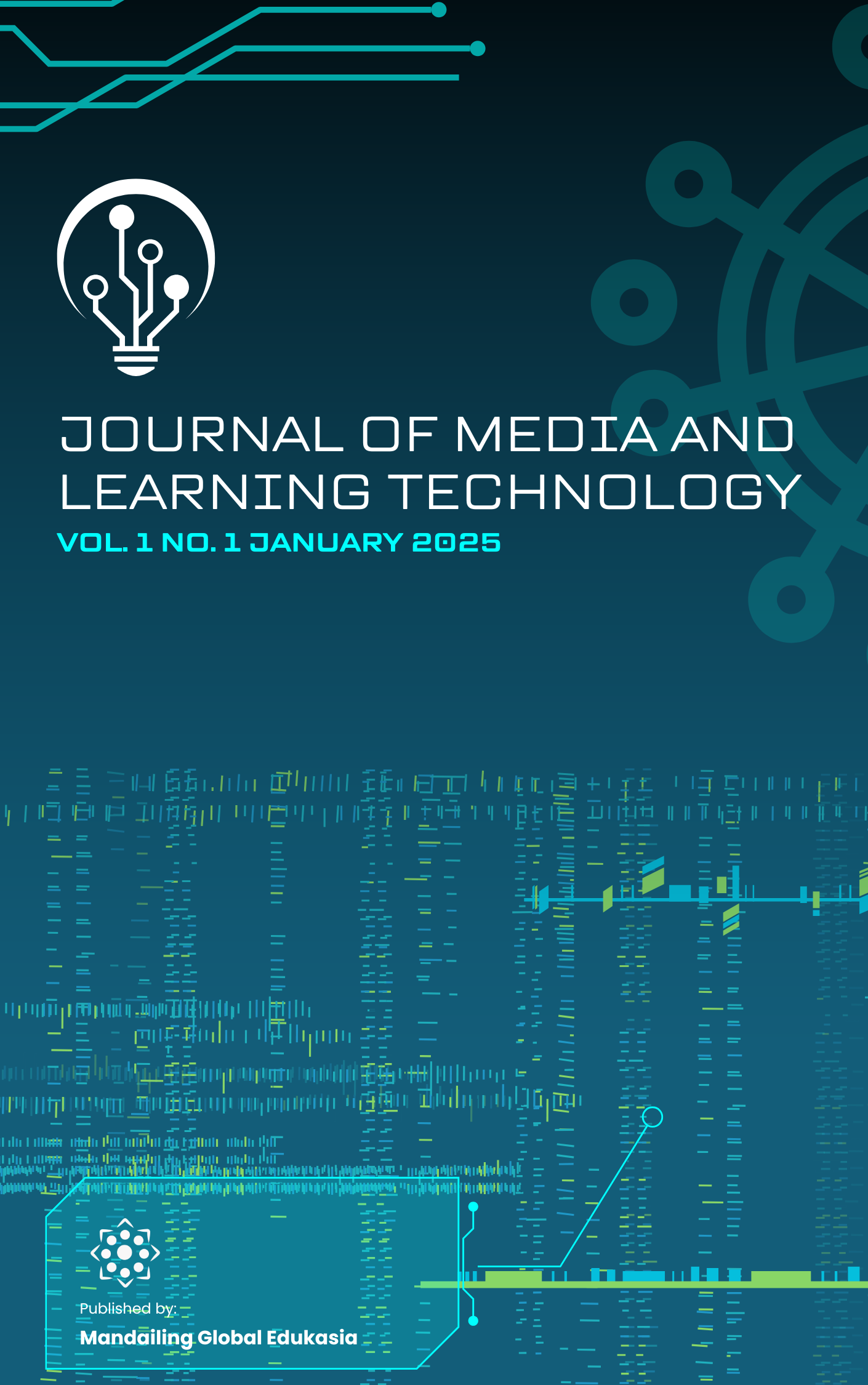Improving Students' Ability in Understanding the Meaning of Faith in Allah's Apostles through the Student Teams Achievement Division Method at SD Negeri 091717 Durian Banggal
DOI:
https://doi.org/10.62945/jmlt.v1i1.97Keywords:
Student ability, faith in Allah's messenger, STAND methodAbstract
This study aims to improve the ability of fourth grade elementary school students to understand the meaning of faith in the apostles of Allah through the application of the Student Teams Achievement Division (STAD) cooperative learning method. The background of this study is the low understanding of students towards the concept of faith in the apostles of Allah, which is indicated by learning outcomes that have not met the minimum completion standards. The STAD method was chosen because it focuses on group cooperation and individual responsibility, so it is expected to improve students' understanding and learning outcomes. This study uses a classroom action approach (CAR) which is implemented in two cycles. Each cycle consists of planning, implementation, observation, and reflection. The subjects of the study were fourth grade elementary school students with a total of 30 participants. Data collection techniques were carried out through evaluation tests, observations, and documentation. The data obtained were analyzed descriptively quantitatively and qualitatively. The results of the study showed that the application of the STAD method can improve students' understanding of the meaning of faith in the apostles of Allah. In cycle I, the percentage of student learning completion reached 70%, while in cycle II it increased to 90%. In addition, student activity and participation in the learning process also showed a significant increase. Thus, the STAD method has proven effective in improving students' ability to understand the meaning of faith in the apostles of Allah. It is recommended for educators to apply this method as an alternative to innovative and enjoyable learning, especially in Islamic Religious Education learning. In addition, it is expected that similar research can be conducted at different grade levels or broader materials to enrich the findings in the application of the STAD method.
Downloads
References
Arikunto, S. (2002). Prosedur Penelitian. Bandung: Rineka Cipta.
Dasopang, M. D., Lubis, A. H., & Dasopang, H. R. (2022). How do Millennial Parents Internalize Islamic Values in Their Early Childhood in the Digital Era? AL-ISHLAH: Jurnal Pendidikan, 14(1), 697–708.
Dasopang, M. D., Nasution, I. F. A., & Lubis, A. H. (2023). The Role of Religious and Cultural Education as A Resolution of Radicalism Conflict in Sibolga Community. HTS Theological Studies, 79(1), 1–7.
Erawadi, E., Hamka, H., & Juliana, F. (2017). The Analysis of Student’s Stressed Syllables Mastery at Sixth Semester of TBI in IAIN Padangsidimpuan. English Education: English Journal for Teaching and Learning, 5(1), 44–57.
Fatimah, A., & Maryani, K. (2018). Visual Literasi Media Pembelajaran Buku Cerita Anak. Jurnal Inovasi Teknologi Pendidikan, 5(1), 61–69. https://doi.org/10.21831/jitp.v5i1.16212
Gogahu, D. G. S., & Prasetyo, T. (2020). Pengembangan Media Pembelajaran Berbasis E-Bookstory untuk Meningkatkan Literasi Membaca Siswa Sekolah Dasar. Jurnal Basicedu, 4(4), 1004–1015.
Hamka, H. (2023). The Role of Principals on Teacher Performance Improvement in a Suburban School. QALAMUNA: Jurnal Pendidikan, Sosial, Dan Agama, 15(1), 371–380.
Hamka, H., Suen, M.-W., Anganthi, N. R. N., Haq, A. H. B., & Prasetyo, B. (2023). The Effectiveness of Gratitude Intervention in Reducing Negative Emotions in Sexual Abuse Victims. Psikohumaniora: Jurnal Penelitian Psikologi, 8(2), 227–240.
Harahap, S. M., & Hamka, H. (2023). Investigating the Roles of Philosophy, Culture, Language and Islam in Angkola’s Local Wisdom of ‘Dalihan Na Tolu.’ HTS Teologiese Studies/Theological Studies, 79(1), 8164.
Hendrawati, S., Rosidin, U., & Astiani, S. (2020). Perilaku hidup bersih dan sehat (PHBS) siswa/siswi di sekolah menengah pertama negeri (SMPN). Jurnal Perawat Indonesia, 4(1), 295–307. https://doi.org/https://doi.org/10.32584/jpi.v4i1.454
Lubis, A. H. (2019). Upaya Peningkatan Hasil Belajar Siswa Sekolah Dasar melalui Model Cooperative Learning Tipe Numered Heads Together. FORUM PAEDAGOGIK, 11(2), 127–143.
Lubis, A. H. (2023). The Interactive Multimedia Based on Theo-Centric Approach as Learning Media during the Covid-19 Pandemic. JPI (Jurnal Pendidikan Indonesia), 12(2), 210–222.
Lubis, A. H., & Dasopang, M. D. (2020). Pengembangan Buku Cerita Bergambar Berbasis Augmented Reality untuk Mengakomodasi Generasi Z. Jurnal Pendidikan: Teori, Penelitian, Dan Pengembangan, 5(6), 780–791.
Lubis, A. H., Dasopang, M. D., Ramadhini, F., & Dalimunthe, E. M. (2022). Augmented Reality Pictorial Storybook: How does It Influence on Elementary School Mathematics Anxiety? Premiere Educandum: Jurnal Pendidikan Dasar Dan Pembelajaran, 12(1), 41–53.
Lubis, A. H., & Wangid, M. N. (2019). Augmented Reality-assisted Pictorial Storybook: Media to Enhance Discipline Character of Primary School Students. Mimbar Sekolah Dasar, 6(1), 11–20. https://doi.org/10.17509/mimbar-sd.v6i1.16415
Lubis, A. H., Yusup, F., Dasopang, M. D., & Januariyansah, S. (2021). Effectivity of Interactive Multimedia with Theocentric Approach to the Analytical Thinking Skills of Elementary School Students in Science Learning. Premiere Educandum: Jurnal Pendidikan Dasar Dan Pembelajaran, 11(2), 215–226.
Manshur, U., & Ramdlani, M. (2019). Media audio visual dalam pembelajaran PAI. Al-Murabbi:Jurnal Pendidikan Agama Islam, 5(1), 1–8.
Mardhiyah, R. H., Aldriani, S. N. F., Chitta, F., & Zulfikar, M. R. (2021). Pentingnya Keterampilan Belajar di Abad 21 sebagai Tuntutan dalam Pengembangan Sumber Daya Manusia. Lectura: Jurnal Pendidikan, 12(1), 29–40.
Ningsih, Y. S., Mulia, M., & Lubis, A. H. (2023). Development of Picture Storybooks with TheoAnthropoEco Centric Approach for Elementary School Students. AL-ISHLAH: Jurnal Pendidikan, 15(2), 1888–1903.
Nurhidayah, I., Asifah, L., & Rosidin, U. (2021). Pengetahuan , Sikap dan Perilaku Hidup Bersih dan Sehat pada Siswa Sekolah Dasar. 13(1), 61–71. https://doi.org/10.32528/ijhs.v13i1.4864
Pebtiyanti, I., Ahmad, A., Dzaky, M., Fauziah, S. N., Rendi, & Puspitasari, P. (2023). Peran kurikulum merdeka dalam meningkatkan harmonisasi antara masyarakat dan sekolah. Jurnal Pacu Pendidikan Dasar, 3(1), 269–277. https://doi.org/https://doi.org/10.22021/pacu.v3i1.411
Rahmah, S., & Lubis, A. H. (2024). Problem Posing as a Learning Model to Improve Primary School Students’ Mathematics Learning Outcomes in Gayo Lues. Journal of Indonesian Primary School, 1(4), 93–104.
Rahman, A., Munandar, S. A., Fitriani, A., Karlina, Y., & Yumriani. (2022). Pengertian Pendidikan, Ilmu Pendidikan dan Unsur-Unsur Pendidikan. Al Urwatul Wutsqa: Kajian Pendidikan Islam, 2(1), 1–8.
Ranisa, R., Erawadi, E., & Hamka, H. (2018). Students’ Mastery in Identifying Adverbs at Grade VIII SMPN 2 Batang Toru Tapanuli Selatan. ENGLISH EDUCATION JOURNAL: English Journal for Teaching and Learning, 6(2), 241–252.
Ricardo, R., & Meilani, R. I. (2017). Impak Minat dan Motivasi Belajar terhadap Hasil Belajar Siswa. Jurnal Pendidikan Manajemen Perkantoran (JPManper), 2(2), 188–201.
Santi, Undang, & Kasja. (2023). Peran Guru PAI dalam Membentuk Karakter Peserta Didik di Sekolah. Jurnal Pendidikan Tambusai, 7(2), 16078–16084. https://doi.org/https://doi.org/10.31004/jptam.v7i2.8918
Sugiyono. (2018). Metode Penelitian Kuantitatif Kualitatif dan R&D. Bandung: Alfabeta.
Downloads
Published
Issue
Section
License

This work is licensed under a Creative Commons Attribution-ShareAlike 4.0 International License.










